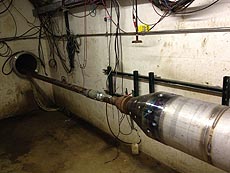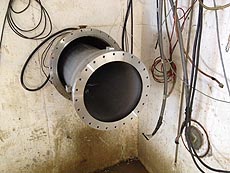Pipe dream fulfilled
 |
This picture, taken this summer, shows a new 12-inch-diameter pipe ready to be inserted into the Neutrino-Muon berm pipe. The Accelerator Division recently finished sleeving the berm pipe, and now the pipe can maintain vacuum for experiments using the beamline. Photo: Ryan Schultz |
For years, vacuum problems plagued Fermilab's 760-foot-long Neutrino-Muon berm pipe and seemed impossible to overcome.
Much to the joy of everyone involved, a team led by AD Project Engineer Ryan Schultz finally put the problem to bed. This summer they successfully inserted a slightly smaller pipe inside the Neutrino-Muon berm pipe. Now experiments such as SeaQuest can maintain vacuum in the beamline.
"It wasn't straightforward, but it really was the only option," Schultz said. "So we found a way to make it work."
Over the pipe's lifetime, water and stray electrical currents helped gradually corrode the steel pipe, allowing groundwater to seep in.
The Accelerator Division had previously attempted to solve the problem, to no avail. They also considered digging out and replacing the pipe, but this would have been both expensive and challenging, given the area's tangled underground nest of electrical feeders, adjacent enclosures, and water and gas lines.
It became clear that sleeving was the only viable option. AD Engineering Physicist Mike Geelhoed called on Schultz to plan and execute the operation.
Sleeving a pipe is typically straightforward. But sleeving the Neutrino-Muon berm pipe was fraught with potential pitfalls. The pipe is over twice as long as a football field and rapidly changes diameter at three points, increasing the potential for the smaller pipe to get caught in the transition regions. Also, the new pipe's environment would be somewhat corrosive, potentially leading to what metallurgists call microbiologically induced corrosion and stress corrosion cracking.
Schultz found a type of stainless steel called Duplex 2205 that would survive the corrosive surroundings.
"It's twice as strong and twice as corrosion-resistant as standard 316 stainless steel but only about 30 percent more expensive, so you get more bang for your buck," Schultz said.
Half of the problem was solved, but the other half remained.
"It doesn't take much for the smaller pipe to get caught," said Geelhoed, who oversaw the project. "The new pipe could have stalled in the transition regions if the front end wasn't designed just right."
Schultz and his team performed practice runs on a full-size mockup. They understood that once they began installing the new pipe, there would be no chance at a do-over.
The tests paid off. At one end, workers assembled 22 sections of pipe, each 35 feet long. Then they welded the sections together and leak-tested as they progressed. At the other end, an 86-ton tugging machine pulled the new pipe through. The team sleeved the pipe in eight weeks.
Schultz points out that Technical Division and other groups contributed to the project.
"Machinists, welders, the Material Development Lab and many others played supportive roles," Schultz said. "AD wouldn't have been successful without them."
The Accelerator Division now has the experience to draw from should another berm pipe start to degrade.
"Hopefully we'll never need it again — knock on wood," Geelhoed said. "If we do, we have the expertise and a successfully proven process. We've got the solution."
—Leah Hesla
 |
The inserted berm pipe is finished and ready to be joined with the adjacent beamline. Photo: Ryan Schultz |
|